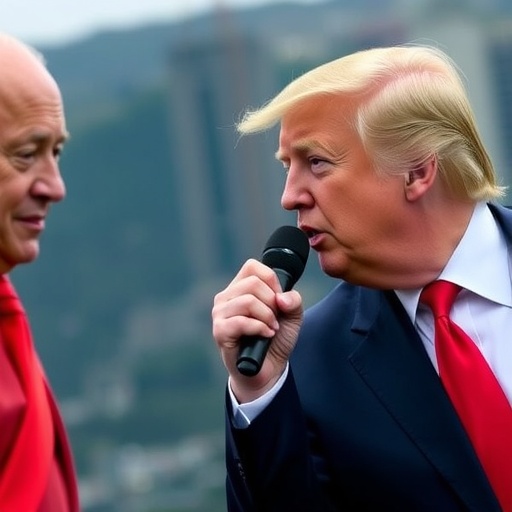Trump Escalates US-China Tensions: New Tariffs Imposed Amid Rare Earth Metals Crisis
In a bold escalation of the long-simmering China Trade Dispute, President Donald Trump announced on Friday a significant increase in Trump Tariffs targeting $200 billion worth of Chinese imports. This move comes directly in response to China’s recent restrictions on exporting Rare Earth Metals, vital minerals that power everything from smartphones to electric vehicles. The decision, detailed in a White House statement, raises tariffs from 10% to 25% on a broad range of goods, including electronics and machinery, signaling Trump’s unwavering approach to protecting American interests in global supply chains.
- China’s Strategic Chokehold: The Roots of Rare Earth Export Limits
- Trump’s Tariff Hammer: Details of the Latest Economic Salvo
- Unveiling the Tech World’s Hidden Dependency on Rare Earths
- Voices from the Frontlines: Economists and Industry Leaders React
- Navigating Stormy Waters: Future Ramifications for Global Trade
The announcement sent shockwaves through international markets, with the Dow Jones Industrial Average dipping 1.2% in early trading and shares in tech giants like Apple and Tesla falling sharply due to their heavy reliance on Chinese-sourced rare earths. “America will not be held hostage by any nation’s monopolistic control over critical resources,” Trump declared during a press briefing at the White House Rose Garden, flanked by key advisors from the Office of the United States Trade Representative (USTR). This latest salvo in the trade war underscores the high stakes involved, as the U.S. seeks to diversify its sources for these irreplaceable materials amid growing geopolitical friction.
China, which controls over 80% of the world’s rare earth production according to data from the U.S. Geological Survey, imposed export curbs last week on seven key rare earth elements, citing environmental concerns and national security. Industry analysts view this as a retaliatory measure following U.S. sanctions on Chinese tech firms like Huawei. The restrictions could disrupt global supply chains, potentially increasing costs for U.S. manufacturers by up to 30%, per a preliminary report from the Peterson Institute for International Economics.
China’s Strategic Chokehold: The Roots of Rare Earth Export Limits
Beijing’s decision to tighten controls on Rare Earth Metals isn’t a sudden whim but a calculated play in the ongoing China Trade Dispute. Rare earths— a group of 17 chemically similar elements like neodymium and dysprosium—are essential for high-tech applications. For instance, neodymium is crucial for the magnets in wind turbines and electric car motors, while europium lights up LED screens in billions of devices worldwide.
Historically, China has dominated this market since the 1990s, when lax environmental regulations allowed it to undercut competitors. Today, it supplies 95% of global refined rare earths, per the International Energy Agency (IEA). The export restrictions, announced by China’s Ministry of Commerce on October 15, limit shipments of samarium, gadolinium, and others to “strategic partners only,” effectively sidelining the U.S. This follows a pattern: In 2010, China briefly cut off rare earth supplies to Japan during a territorial spat, causing prices to skyrocket 500% overnight.
Experts point to U.S. policies as a trigger. “The Biden administration’s export controls on advanced semiconductors to China earlier this year prompted this response,” said Dr. Li Wei, a trade economist at Peking University, in an interview with Reuters. “Beijing is signaling that it holds leverage in the minerals arena.” U.S. officials, however, dismiss this as economic coercion. Commerce Secretary Gina Raimondo testified before Congress last month that diversifying rare earth sources is a national security imperative, warning that over-reliance on China poses risks akin to oil dependence in the 1970s.
The impact is already palpable. Lynas Rare Earths, an Australian firm mining in Malaysia, saw its stock surge 15% on news of the curbs, as investors bet on non-Chinese alternatives. Meanwhile, American companies like MP Materials in California, which operates the Mountain Pass mine—the only active rare earth site in the U.S.—ramped up production by 20% this quarter, according to company filings. Yet, building a full domestic supply chain could take years and billions in investment, estimated at $5 billion by the Department of Energy.
Trump’s Tariff Hammer: Details of the Latest Economic Salvo
True to form, President Trump’s response leverages his signature tool: Trump Tariffs. The new measures, formalized under Section 301 of the Trade Act of 1974, target 2,000 product categories from China, including lithium-ion batteries and solar panels—industries intertwined with rare earth processing. Effective November 1, these tariffs aim to pressure Beijing into lifting its restrictions while incentivizing U.S. firms to reshore operations.
“This is classic Trump—using tariffs as a negotiating cudgel,” noted Peter Navarro, Trump’s former trade advisor, in a Fox News op-ed. “It worked before; it will work again.” During his first term, Trump imposed tariffs on $360 billion in Chinese goods, leading to a Phase One trade deal in 2020 that included agricultural purchases but fell short on structural reforms. Critics, however, question the strategy’s efficacy. A study by the National Bureau of Economic Research found that previous Trump Tariffs cost U.S. consumers $51 billion annually in higher prices, with limited gains in manufacturing jobs.
The White House justifies the hikes by citing national security. In a memo released alongside the announcement, USTR Katherine Tai highlighted how Rare Earth Metals underpin the U.S. defense sector: F-35 fighter jets require 920 pounds of rare earths each, and missile guidance systems rely on yttrium for precision optics. “China’s actions threaten our technological edge,” Tai stated. To mitigate domestic fallout, the administration pledged $1.2 billion in subsidies for alternative sourcing, drawing from the CHIPS and Science Act’s $52 billion semiconductor fund.
Business reactions are mixed. The Consumer Technology Association warned of price hikes—smartphones could cost 10-15% more—while the American Iron and Steel Institute praised the move for protecting steel alloys that incorporate rare earths. Globally, the European Union, which imports 98% of its rare earths from China, is monitoring closely; EU Trade Commissioner Valdis Dombrovskis called for multilateral talks to avoid a fragmented market.
Unveiling the Tech World’s Hidden Dependency on Rare Earths
At the heart of this China Trade Dispute lies the indispensable role of Rare Earth Metals in the digital age. These elements aren’t just niche; they’re the backbone of innovation. Consider: A single electric vehicle uses up to 10 pounds of rare earth magnets, enabling efficient motors that reduce emissions by 40% compared to gas engines, according to the Union of Concerned Scientists.
The U.S. tech sector alone consumed 12,000 metric tons of rare earth oxides in 2022, per USGS estimates, fueling everything from iPhone speakers to data center cooling systems. Apple’s supply chain report reveals that 60% of its rare earths come from China, prompting the company to invest $250 million in recycling programs. Similarly, Tesla’s Gigafactory in Nevada incorporates rare earth-free motors in some models, but CEO Elon Musk tweeted last week, “Diversification is key, but China’s dominance is a real bottleneck.”
Beyond consumer goods, rare earths are pivotal in green energy. Wind turbines require terbium for corrosion-resistant coatings, and solar panels use lanthanum in purification processes. The IEA projects global demand will quadruple by 2040, driven by net-zero goals, yet supply lags. China’s restrictions could delay U.S. renewable projects by 6-12 months, inflating costs by $10 billion, warns a BloombergNEF analysis.
Environmental angles add complexity. Rare earth mining is notoriously polluting—China’s Bayan Obo site has contaminated water sources with radioactive thorium. U.S. efforts to revive domestic mining face hurdles: The Mountain Pass facility, once shuttered in 2002 due to low prices, now processes only 15% of its ore on-site, shipping the rest to… China for refinement. Initiatives like the Pentagon’s $120 million rare earth stockpile aim to bridge this gap, but experts like Julie Klinger, author of “Rare Earth Frontiers,” argue for international alliances with allies like Australia and Canada, which hold 20% of global reserves.
Voices from the Frontlines: Economists and Industry Leaders React
The imposition of fresh Trump Tariffs has ignited a firestorm of opinions, with stakeholders dissecting the pros and cons in real time. “This escalates the China Trade Dispute into uncharted territory, risking a full decoupling of supply chains,” cautioned Adam Posen, president of the Peterson Institute, during a CNBC panel. “While tariffs protect jobs short-term, they stifle innovation long-term—U.S. firms need access to these metals to compete.”
On the pro-tariff side, labor unions are vocal supporters. AFL-CIO President Richard Trumka Jr. lauded the move in a statement: “Finally, a stand against China’s unfair practices that have hollowed out American manufacturing. Rare earth production could bring 5,000 jobs to rural U.S. communities.” Statistics back this: The U.S. rare earth industry employed just 1,200 workers in 2022, versus China’s 100,000, per industry reports.
International perspectives vary. Japan’s Ministry of Economy, Trade and Industry echoed U.S. concerns, recalling its 2010 crisis, and pledged $500 million to joint ventures with the U.S. In contrast, Chinese state media like Xinhua decried the tariffs as “bullying,” quoting Foreign Ministry spokesperson Zhao Lijian: “The U.S. seeks to contain China’s rise, but this will boomerang on its own economy.” Market data supports unease: Rare earth prices on the Shanghai Metals Market jumped 25% post-restrictions, hitting $80 per kilogram for dysprosium oxide.
Small businesses feel the pinch acutely. A survey by the National Federation of Independent Business found 40% of U.S. manufacturers reliant on Chinese imports fear cost surges, with 22% considering layoffs. Yet, optimists highlight opportunities: Startups like Noveon Magnetics in Texas are developing recycling tech that recovers 90% of rare earths from e-waste, potentially cutting import needs by 30% within five years.
Politically, the tariffs bolster Trump’s image ahead of midterms. Polling from Gallup shows 55% of Republicans approve of aggressive trade policies, though overall support dips to 42% amid inflation worries. Democrats, led by Senate Majority Leader Chuck Schumer, called for bipartisan legislation to fund rare earth R&D, warning, “Tariffs alone won’t solve this; we need a comprehensive strategy.”
Navigating Stormy Waters: Future Ramifications for Global Trade
As the dust settles on this latest chapter of the China Trade Dispute, the path forward bristles with uncertainty. The new Trump Tariffs may force negotiations, but history suggests prolonged standoffs. Recall the 2018-2019 trade war, which shaved 0.3% off U.S. GDP, per Federal Reserve estimates, while China’s economy grew 6% despite pressures.
Looking ahead, the U.S. is accelerating diversification. The Inflation Reduction Act allocates $369 billion for clean energy, including rare earth incentives, aiming to boost domestic output to 25% of global needs by 2030. Partnerships with Greenland and Vietnam for new mines could yield results within 18 months, though geopolitical risks loom—Vietnam’s deposits are near contested South China Sea waters.
For consumers, expect ripple effects: Higher Rare Earth Metals costs could add $400 to the price of an average EV by 2024, according to McKinsey projections. Tech innovation might accelerate alternatives, like iron-nitride magnets that sidestep rare earths entirely, but scaling takes time. Globally, the WTO could intervene if tariffs violate trade rules, though enforcement has been spotty.
Ultimately, this dispute tests the resilience of interconnected economies. As Trump himself put it, “We’re fighting for America’s future.” Whether this leads to a breakthrough deal or deeper entrenchment remains to be seen, but one thing is clear: The battle over Rare Earth Metals will shape the next decade of trade, technology, and security.










